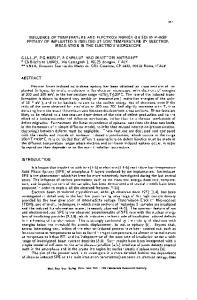Hall effect measurements at low temperature of arsenic implanted into 4H-silicon carbide
- PDF / 53,047 Bytes
- 5 Pages / 612 x 792 pts (letter) Page_size
- 96 Downloads / 346 Views
Hall effect measurements at low temperature of arsenic implanted into 4H-silicon carbide J.Senzaki1,2, K.Fukuda1,2, Y.Ishida1,2, Y.Tanaka1,2, H.Tanoue1, N.Kobayashi1,2, T.Tanaka1,3 and K.Arai1,2 1 Ultra-Low Loss Power Device Technologies Research Body, 2Electrotechnical Laboratory, 3 R&D Association for Future Electron Devices, c/o Electrotechnical Laboratory 1204, 1-1-4, Umezono, Tsukuba, Ibaraki, 305-8568, JAPAN ABSTRACT The arsenic dose dependence of electrical properties for implanted samples at 500°C and subsequently annealed at 1600°C for 30min has been investigated to derivate the activation energies of the arsenic donors in silicon carbide. Hall effect measurements were performed between 20K and 773K. Hall carrier concentration of implanted sample with high dose of 7x1015 cm-2 is independence of temperature, which indicates the formation of implanted layer with metallic conduction. For the sample with low dose of 1x1014 cm-2, the experimental Hall mobility varies directly as T 3/2 below 80K and as T -3/2 above 150K. The activation energies of arsenic donors determined from the implanted sample with low dose using a least-squares fit of the charge neutrality equation are 66.8 meV for hexagonal site and 127.0 meV for cubic site, respectively. INTRODUCTION Silicon carbide (SiC) has a potential to yield new devices with functional capabilities that is far better than the one based on silicon semiconductor because of its wide bandgap (~ 3 eV), high breakdown field (~ 3x106 V/cm) and high thermal conductivity (~ 4.9 W/cmK). From this reason, there has been significant activity in developing SiC devices during the past few years [1-3]. For the SiC device fabrications, it is indispensable to develop the impurity doping technique. Ion-implantation has been expected as the promising candidate for a selective doping method, which forms source/drain of metal-oxide-semiconductor field-effect-transistors (MOSFETs) and guard-ring areas of Schottky barrier diodes (SBDs). Accurate knowledge of the electrical properties of impurities in semiconductor is important for the design and performance of SiC electronic devices A lot of investigations for n-type dopants into SiC using ion-implantation have been reported. Nitrogen (N) is the most prevalent dopant due to unintentionally incorporation into SiC during crystal growth and formation of shallow donor levels. Nitrogen donors in both 4H-SiC and 6H-SiC exhibit different activation energies when hexagonal (h) or cubic (k) lattice sites were occupied. The activation energies of two nitrogen donors in 4H-SiC have been identified with activation energies of E(Nh)=52.1 and E(Nk)=91.8 meV using Hall effect and infrared (IR)-absorption measurements [4]. Scott et al. reported that the donor activation energy was determined to be 46 meV for the phosphorus (P) implanted 4H-SiC by Hall effect measurement [5]. Arsenic (As) is also known well as an n-type dopant in silicon devices. Arsenic has low diffusion coefficient in Si (about one-tenth of P). This property makes As dopant attractive to
Data Loading...








